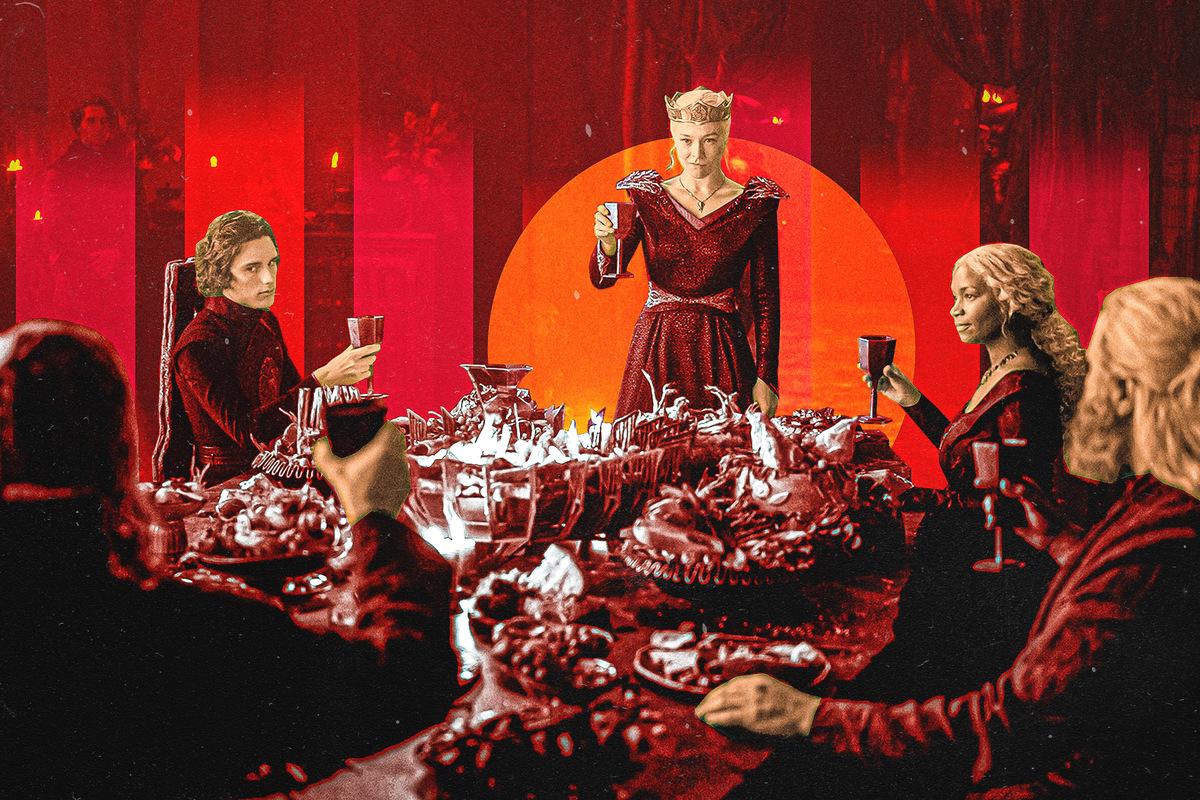The Season 2 Finale of ‘House of the Dragon’ Is a Buildup and a Letdown
The finale feels like more of a midseason episode—and setup for an exciting Season 3

Exactly two months ago, before the start of Season 2 of House of the Dragon, I predicted that this season of television would resemble Game of Thrones at its best. Season 2 would have more battles, a larger cast of characters, and a smoother timeline than Season 1—all of which would allow the prequel to level up closer to the monocultural phenomenon that was peak Thrones.
That prediction proved mostly correct. Dragon Season 2 was a true television triumph, with three particular highlights: Rhaenyra’s surreptitious conversation with Alicent in the Grand Sept, the battle at Rook’s Rest, and the Red Sowing. It even followed Thrones’ general tradition of following up spectacle-laden penultimate episodes with more muted finales.
But in Dragon’s case, that quieter finale proved to be more of a letdown than a compelling capstone. Episode 8 didn’t take away from the season’s earlier splendor, but Dragon Season 2 ends with a whimper, not a bang.
The finale’s problems start with an overarching structural issue: Season 2 was only eight episodes long, instead of extending to the 10 hours of Season 1. This was a bad omen from the beginning—shortening seasons has harmed Thrones properties before—especially because it was an executive decision rather than a creative one. Writer Sara Hess told Entertainment Weekly in May, “It wasn’t really our choice.”
The result was an abrupt end that blunted a season’s worth of momentum toward a battle. Consider the closing moments, as Westeros prepares for further, larger-scale war. In a vacuum, this is a strong montage: Rhaenyra’s new dragonriders are fitted for armor; the Hightowers, Starks, and Lannisters all lead marching armies (the recognizable house themes for the Starks and Lannisters blend into the montage score, which is a nice touch), while the Velaryons and Triarchy contribute new ships to the cause; and two new dragons—Tessarion, with the Hightowers, and Sheepstealer, in the Vale—appear for the first time.
This montage sets the scene—but that’s the goal of a midseason episode, not the conclusion of a season before a long break. “We must strike while we have the advantage and end this war,” Rhaenyra tells her new dragonriders in Episode 8. “You will fly in two days’ time.”
But for audiences, that wait will be more like two years’ time, if Dragon is gone as long between Seasons 2 and 3 as it was between Seasons 1 and 2. That’s to be expected, given the amount of CGI required to animate this dragon-heavy show. (In the meantime, the next Thrones spinoff, A Knight of the Seven Kingdoms, is slated to reach screens in 2025.)
Dragon spends almost all season previewing the coming melee in the Riverlands. Characters on both sides of the war stress the strategic importance of Harrenhal, then recruit allies to converge on the area—but that promise receives no payoff within the season. In Season 2, as Rhaenyra says, “blood has been shed, cities burned,” but not at the scale teased by the show.
Or, put another way: Season 1 ended with a continent on the brink of war, and Season 2 ends with … a continent on the brink of more war. But returns diminish when every season ending rhymes with the last one.
I won’t go as far as Aegon in this episode and ask, “What was the fucking point of all this?” but I will label this ending an unfulfilling cliff-hanger. The delay is reminiscent of a sore spot from the Thrones books, as George R.R. Martin needed to move the so-called battles of fire (in Meereen) and ice (outside Winterfell) from the fifth book to the still-unpublished sixth because he’d run out of space in the former.
Moreover, although the season finale included some touching moments, it also suffered from a bizarre distribution of screen time. The episode devotes excessive attention to Tyland Lannister’s recruitment of the Triarchy (four scenes in the finale) and Rhaena’s run through the Vale in search of a dragon (four more scenes).
This focus on more peripheral characters comes at the expense of regulars such as Otto Hightower (now mysteriously imprisoned) and Criston Cole, who doesn’t appear at all in Episode 7 and receives just one scene in Episode 8. (At least Dragon puts that brief time to good use: Criston aptly summarizes the themes of the show when he muses, “The dragons dance, and men are like dust under their feet.”)
The finale does give plenty of attention to Daemon, as his Alys-induced hallucinations reach their zenith with a trip to Harrenhal’s godswood. But here, the episode’s largest potential problem emerges. Daemon sees a number of images in this vision: a three-eyed raven, a dragon corpse, Rhaenyra seated on the Iron Throne. But most relevant to viewers is a series of familiar sights and sounds: a White Walker leading the army of the dead, eggs in a fire, and distant descendent Daenerys Targaryen hatching three dragons. Daemon even says, “Winter is coming” in High Valyrian when Rhaenyra arrives at Harrenhal.
This montage goes beyond sly Easter eggs and rings alarm bells for two main reasons. First, the overt reminders of Walkers and Daenerys connect Dragon to some of the worst, most reviled parts of Thrones (the Walkers’ underwhelming demise and Daenerys’s turn in “The Bells”).
While attempts to rehabilitate down moments in a franchise, if that’s what Dragon showrunner Ryan Condal is trying to do, can succeed—Avengers: Endgame successfully incorporates Thor: The Dark World—this choice carries immense risk. We don’t want all Thrones stories to end up like modern Star Wars content, stuck explaining the “how” in The Rise of Skywalker’s infamous “somehow, Palpatine returned.”
I wonder if, in seeming to make the prequel so subordinate to the original Thrones, Dragon’s writers are underestimating the appeal of their own show. In my view, Dragon is sufficiently strong enough on its own that it doesn’t need to tightly grab onto Thrones’ coattails to generate audience excitement. But these sorts of connections to Thrones have been built into Dragon ever since the introduction of Aegon the Conqueror’s prophecy in the pilot—when the creators didn’t know their show would become a smash hit and therefore might have felt more of a need for such explicit links.
The second issue with this sequence is that it—along with other moments from the finale—raises the broader question of whether the characters in this story have free will. “All your life, you have sought to command your own fate,” Alys tells Daemon before showing him this weirwood vision. But is the converse true: that fate commands Daemon?
Another exchange in this episode seems to affirm this theory. When Helaena reveals she knows that Aemond burned Aegon at Rook’s Rest, then prophesies the prince regent’s death, Aemond seethes, “I could have you killed.” But Helaena, unmoved, responds, “It wouldn’t change anything.”
That’s a different sort of predestination from the kind other characters express in this episode. When Rhaenyra tells Alicent, “My part is here, whether I will or no. It was decided for me long ago,” she is almost wistfully reflecting on how she’s long felt forced on her path to the Iron Throne because of her birth. That dynamic can make for a strong arc, full of tricky choices about whether to pursue desires (Criston and a trip to Essos?) or duty. But if nobody’s choices matter because the story’s ultimate outcome is already locked in, then the individual and narrative dramas lose much of their luster.
If this review of the Season 2 finale seems excessively harsh, that’s perhaps because the rest of the season raised Dragon’s bar so high. Without the additional weight of Season 1’s time jumps and throat-clearing, and with a more consistent cast and tighter timeline, Season 2 had a higher ceiling and floor; it presented spectacular set pieces, executed shocking moments from the source text, and added some new adaptive flavors of its own. Even this finale is a fine episode of television by itself; it’s only in comparison to its recent predecessors, and in its placement as a season conclusion, that the episode disappoints relative to expectations.
And through two seasons now, House of the Dragon is mapping the rough trajectory of Thrones, which followed a thrilling Season 1 with a more expansive Season 2, complete with intriguing new characters (such as Davos and Melisandre on the one hand and Ulf and Alys on the other), new places, and new drama. After Season 2, of course, Thrones ratcheted up its quality even more, leading to a tremendous run in Seasons 3 and 4.
It remains to be seen whether Dragon will keep charting that course, but the glass-half-full view of an ending with too much buildup and not enough action is that the climax has to come eventually. From that perspective, Season 3 might be even more like Thrones at its best.
Have HotD questions? To appear in Zach’s weekly mailbag, message him @zachkram on Twitter/X or email him at zach.kram@theringer.com.


